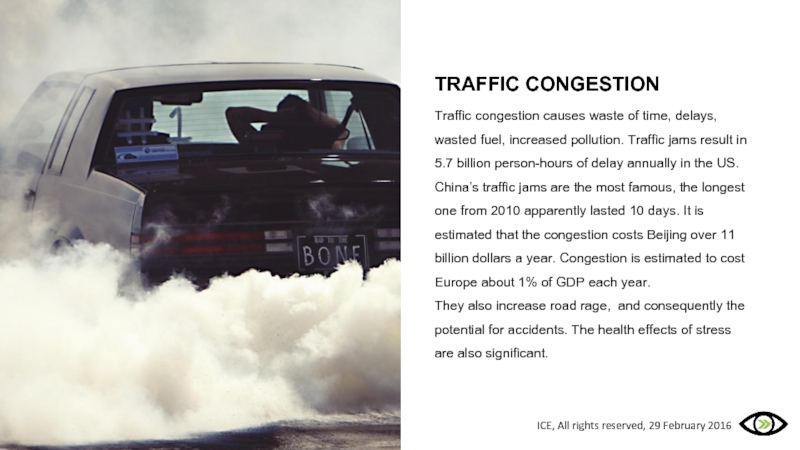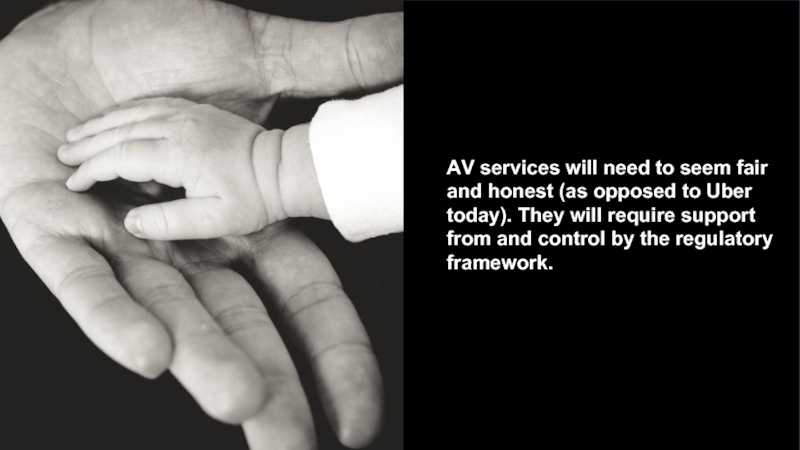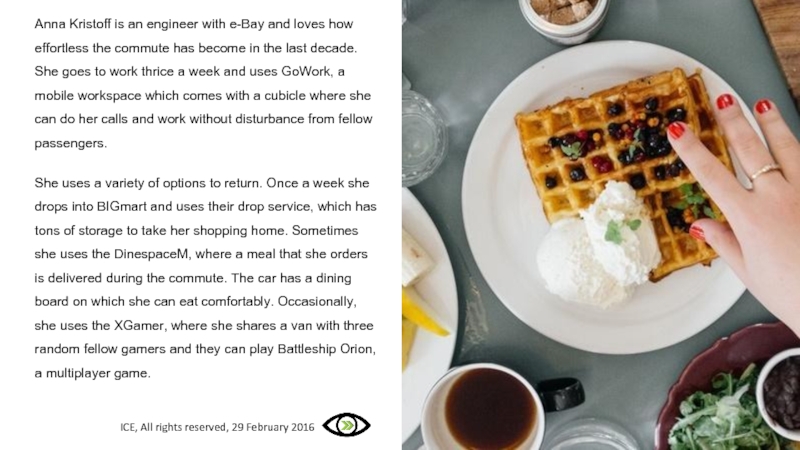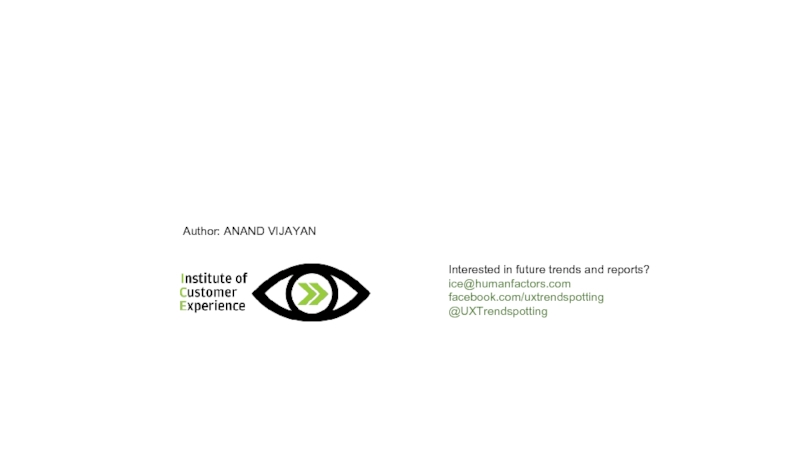- Главная
- Разное
- Дизайн
- Бизнес и предпринимательство
- Аналитика
- Образование
- Развлечения
- Красота и здоровье
- Финансы
- Государство
- Путешествия
- Спорт
- Недвижимость
- Армия
- Графика
- Культурология
- Еда и кулинария
- Лингвистика
- Английский язык
- Астрономия
- Алгебра
- Биология
- География
- Детские презентации
- Информатика
- История
- Литература
- Маркетинг
- Математика
- Медицина
- Менеджмент
- Музыка
- МХК
- Немецкий язык
- ОБЖ
- Обществознание
- Окружающий мир
- Педагогика
- Русский язык
- Технология
- Физика
- Философия
- Химия
- Шаблоны, картинки для презентаций
- Экология
- Экономика
- Юриспруденция
Automated Vehicles and the Future of Urban Transport презентация
Содержание
- 1. Automated Vehicles and the Future of Urban Transport
- 2. A little parable about transportation At
- 3. TOO MANY CARS Too many people own
- 4. TRAFFIC CONGESTION Traffic congestion causes waste of
- 5. HEALTH AND OTHER COSTS Breathing street-level fumes
- 6. SPACE Roads and parking take up valuable
- 7. TIME AND FUEL Not to mention the
- 8. “Today, cars are people’s second-largest household
- 9. SELF-DRIVING TECHNOLOGY AND AUTOMATED VEHICLES Several
- 10. AVs are expected to hit the
- 11. It is the potential to reimagine the commute experience that makes AVs so exciting.
- 12. Automated Vehicles offer several advantages Reduced
- 13. WHAT DOES THIS DO TO COMMUTE EXPERIENCE?
- 14. WHAT DOES THIS MEAN FOR URBAN PLANNING?
- 15. WHAT DOES THIS MEAN FOR CAR COMPANIES?
- 16. WHAT DOES THIS MEAN FOR VEHICLE DESIGN?
- 17. But for all this to work,
- 18. An OCED simulation experiment found that a
- 19. Citylab suggests that an "internet of cars"
- 20. More and more Millennials would rather rent
- 21. Product Innovations such as Google’s self-driving cars,
- 22. With all this in place, the
- 23. 2020 – 2030: Engineering-led The
- 24. AVs will debut in small towns where
- 25. Regulatory frameworks will have to be
- 26. 2030 – 2040: Innovation-led
- 27. CHALLENGES AND REQUIREMENTS Having managed to
- 28. AV services will need to seem
- 29. 2040 – 2050: Regulation-led Slowly
- 30. While developing services, much can be
- 31. Let us now explore Three Scenarios Circa 2030
- 32. SCENARIO 1: BERKELEY The first places
- 33. Joe Stiegler is an Asst Professor of
- 34. After her school day is done, his
- 35. SCENARIO 2: SAN FRANCISCO One decade
- 36. Anna Kristoff is an engineer with e-Bay
- 37. Walks in the city are now passé.
- 38. SCENARIO 3: MUMBAI Self-driving cars have
- 39. The Dabbawalas of Bombay were known for
- 40. But when drone technology got reliable enough
- 41. In the midst of all the excitement about AVs, Don’t forget the basics
- 42. AVs come with a tendency towards
- 43. Multiple modes of ownership will need
- 44. CITY PLANNING WITH AVs Walkability: A
- 45. TRANSPORT AS SYSTEM AVs cannot replace
- 46. KEEP EXPERIMENTING We also need
- 47. Sources: CityLab Future of Transportation series Embarq
- 48. Pagewise Photo Credits: 1 Alex Mihis
- 49. Interested in future trends and reports? ice@humanfactors.com facebook.com/uxtrendspotting @UXTrendspotting Author: ANAND VIJAYAN
Слайд 2
A little parable about transportation
At first, people used to get around
Soon, more people got rich enough to buy cars. And the roads got a little clogged. And the average travel time rose to about an hour. And this led to more people buying cars and the roads being perennially jammed! And travel time rose to two hours. And people were paying so much more for this slower transport system.
But then this is no parable. This is the history of modern transport.
Слайд 3TOO MANY CARS
Too many people own too many cars—an estimated 1.2
Слайд 4TRAFFIC CONGESTION
Traffic congestion causes waste of time, delays, wasted fuel, increased
They also increase road rage, and consequently the potential for accidents. The health effects of stress are also significant.
Слайд 5HEALTH AND OTHER COSTS
Breathing street-level fumes for just 30 minutes can
The WHO reports that over a million people die and some 20 - 30 million people are injured in road accidents each year. Add to this, lost productivity, medical costs, legal and court costs, emergency services, administrative costs, congestion costs, property damage, and workplace losses.
Слайд 6SPACE
Roads and parking take up valuable real estate. In countries with
Слайд 7TIME AND FUEL
Not to mention the several billion hours spent driving
All that traffic costs 3 billion gallons of fuel and 7 billion hours of time. In 2014, that added up to $160 billion.
Слайд 8
“Today, cars are people’s second-largest household expenditure, and they sit unused
If someone described that model to you and didn’t tell you it was cars, you’d say it was ripe for disruption.”
http://www.wired.com/2016/01/the-metastructure-transportation/
Слайд 9SELF-DRIVING TECHNOLOGY AND AUTOMATED VEHICLES
Several technological breakthroughs promise to alleviate the
But Self-Driving Technologies or Automated Vehicles (AVs) promise the greatest disruptive potential.
They can reduce the cost of transport drastically, offer greater possibilities for sharing and allow for innovation that parallels the IT revolution of the last three decades.
Слайд 10
AVs are expected to hit the market by 2020.
Yes, they will
… but the disruptive potential comes from the system changes that they enable: SHARED MOBILITY
Слайд 12
Automated Vehicles offer several advantages
Reduced Congestion
Reduced Emission
Space freed: No need for
Disabled, elderly, and children are more mobile and safe
Finance freed up: No need for that car loan
Move up: Rent a BMW at a lower price than owning a VW
No Drunk Driving / Accidents
Less cars needed: Reduced ecological impact.
Слайд 13WHAT DOES THIS DO TO COMMUTE EXPERIENCE?
These cars are well behaved.
The absence of the driver allows these to be extremely cooperative as services. Shared Mobility creates options for door-to-door travel, last/first mile trips, reaching underserved areas. Disabled, aged and young people can be served.
Слайд 14WHAT DOES THIS MEAN FOR URBAN PLANNING?
Reduced need for parking spaces.
Less vehicles on the road and reduced need for parking imply increased space for other uses like housing, business, playgrounds, parks, etc.
Слайд 15WHAT DOES THIS MEAN FOR CAR COMPANIES?
Auto companies will move from
Слайд 16WHAT DOES THIS MEAN FOR VEHICLE DESIGN?
CAR AS SPACE, NOT JUST
Since there is no more need to orient the driver facing outside, it allows for a more sociable/ interactive commute experience for families and groups.
The increased freedom in the design of cars allows them to be multipurpose vehicles. They can now be used to for several other purposes— business, entertainment, lounging, personal care.
Слайд 17
But for all this to work, there needs to be a
in the Car Paradigm: from OWNING to SHARING
Слайд 18An OCED simulation experiment found that a fleet of just 26,000
A similar effort at modelling usage by the University of Texas, Austin, found that by sharing usage it would be possible to make do with a tenth of the vehicles with little or no change in convenience.
Martyn Briggs of Frost & Sullivan, estimates that “each shared vehicle could ultimately replace between 6 and 15 privately owned cars.”
www.internationaltransportforum.org Urban Mobility System Upgrade: How shared self-driving cars could change city traffic http://www.citylab.com/commute/2014/02/imagine-world-where-nobody-owns-their-own-car/8387/
One-tenth of the cars:
Same Mobility
Слайд 19Citylab suggests that an "internet of cars" — a world where
The Mobility as a Service model is already in place with the likes of Uber, Lyft, etc. This comes rather timely as we discover a new preference by Millenials to user rather than own.
http://www.citylab.com/commute/2014/02/world-without-car-crashes/8353/
AN INTERNET OF CARS..
Слайд 20More and more Millennials would rather rent than own cars. Around
The Fraunhofer Institute notes a tendency towards using instead of owning in urban regions, owing to advantages like "cost/benefit optimisation, being able to do without maintenance and repairs, sustainability aspects, flexibility through continuous choices."
http://www.isi.fraunhofer.de/isi-wAssets/docs/e-x/working-papers-sustainability-and-innovation/WP3-2011_VIVER-english-Version.pdf
THERE’S ALREADY A CHANGE IN ATTITUDE…
Слайд 21Product Innovations such as Google’s self-driving cars, Transport Fleet Management Software,
THIS WILL ALSO NEED SEVERAL CHANGES IN THE SYSTEM
Regulatory Innovations to guide and smoothen the operating environment. Data privacy and interoperability. As also liability for accidents and the ‘ethics’ of the software.
Process Innovations such as new ways of paying for transport, using chips/ phones/ cards. These will be required in the short term to make smoothen user experience.
But in the long run, Market Innovations like Shared Mobility, and experiments like Free Transport will be the game changers. Look at Singapore to lead the way.
Слайд 22
With all this in place, the transition to AVs is likely
Ford has peer-to-peer car sharing for its employees, and plans to let groups of people lease its cars. BMW’s piloted a car share program in the Bay Area. Audi and Daimler have launched their own car sharing services.
Слайд 23
2020 – 2030: Engineering-led
The key driver will be the improved technological
Setting up Human Machine Interaction protocols will be among the early challenges.
Слайд 24AVs will debut in small towns where the ‘cautious programming’ that
Through the decade, the software that runs the car will get sophisticated enough to handle denser traffic and the public will gain enough confidence in AVs to begin depending on them regularly.
Слайд 25
Regulatory frameworks will have to be put in place to enable
Liability, terms of service, constraints on ownership, etc. will have to be spelt out.
The regulatory framework will have to be kept nimble to deal in a quick and timely manner with the rapid changes of the next two decades.
CHALLENGES AND REQUIREMENTS
The first round of challenges will be in the space of human-car communication. How will the presence of self-driving cars change the driving environment? How will pedestrians deal with the strange cars that move by themselves?
Key players will lobby to remove legal barriers ensuring quick adoption of AVs. Where feasible, a separate right of way may be implemented. When taxi operators begin to induct them in their fleets, protests from drivers will lead to regulatory checks on AVs in some places.
Слайд 26
2030 – 2040: Innovation-led
Self-driving technology will be good enough to
Cheaper, better technology will make AVs the preferred mode of transport. Businesses will develop around AVs. Innovative models of shared ownership and services will proliferate, and vie with each other to deliver personalized differentiated experiences.
Слайд 27CHALLENGES AND REQUIREMENTS
Having managed to run successfully in the first world,
As self-driving expands into the third world, increased protests and resistance to AVs will turn violent. But certain services will be so dramatic in their usefulness that public opinion will tilt strongly towards AVs.
As drivers lose jobs, it will be necessary to put in place schemes to help them take advantage of the new opportunities that AVs offer.
Cities will tend to sprawl, negating many of the promised advantages of AVs. It will take enlightened governments to keep this in check.
The growing power of the AV lobby to will also need to be restrained to keep them from completely undermining the fundamentals of town planning.
Слайд 28
AV services will need to seem fair and honest (as opposed
Слайд 29
2040 – 2050: Regulation-led
Slowly but steadily, human driving will be banned
CHALLENGES AND REQUIREMENTS
Regulation will have the opposite challenge now: to ensure that AVs and their overarching power does not result in monopolistic or exploitative practices. (This is possible on account of the shortage of private vehicles and the complete dependence on mobility service providers – not unlike the dependence by farmers on seed companies today.)
Precautions will also have to be taken to ensure that vital transport services and networks are not compromised in the event of hacking of the transport management system or if the corporate managing it turns hostile.
Слайд 30
While developing services, much can be learnt from the airline business..
Delight
Personalization
Business enablement
Слайд 32SCENARIO 1: BERKELEY
The first places to see self-driving vehicles in a
The advantage of being rentable rather than owned, combined with the convenience of allowing interaction makes them extremely popular with students.
Слайд 33Joe Stiegler is an Asst Professor of Linguistics in the New
He wakes and fixes a quick breakfast for his daughter before her school bus arrives to pick her up. He then gets ready and a single seater car-pod comes to take him to the department.
His mother is visiting. The Transport App allows him to have her picked up and dropped at his department as he finishes class. They have lunch together and she waits in the library.
Слайд 34After her school day is done, his daughter hops into a
At the library, she spends a couple of hours with her grandmother. Then her father joins them and they return home walking, after having dinner at the college canteen.
Слайд 35SCENARIO 2: SAN FRANCISCO
One decade after their introduction, AVs are used
They are popular with the tech crowd that also has the money to buy more and more property farther and farther away from the city for large houses, leading to unprecedented, unsustainable sprawl.
Слайд 36Anna Kristoff is an engineer with e-Bay and loves how effortless
She uses a variety of options to return. Once a week she drops into BIGmart and uses their drop service, which has tons of storage to take her shopping home. Sometimes she uses the DinespaceM, where a meal that she orders is delivered during the commute. The car has a dining board on which she can eat comfortably. Occasionally, she uses the XGamer, where she shares a van with three random fellow gamers and they can play Battleship Orion, a multiplayer game.
Слайд 37Walks in the city are now passé. The large number of
With sky rocketing real estate prices in the city and a hundred miles around (a 3 hour commute is normal), her house—like many others—is well over 200 miles outside the city.
The large number of cars plying the roads all the time gives San Francisco the new epithet MobileCity, where everything seems to be moving. Only the rich can afford fixed spaces and services. The middle class exists in a completely shifting world. Tourists are amazed at the range of mobile services.
Her parents can’t stand it, they never visit her here.
Слайд 38SCENARIO 3: MUMBAI
Self-driving cars have taken over about 90% of the
The city administration of Mumbai is emulating Singapore in limiting personally owned vehicles to just 10% of the population. There has been substantial investment in large public transit.
AVs serve as feeders to the metro and trains.
Mumbai’s shortage of space for housing and business makes AVs a fertile bed for enterprise.
Слайд 39The Dabbawalas of Bombay were known for their reliable and affordable
When AVs became commonly available in 2025, e-Kart invested in a fleet to change their logistics model entirely. The role of people was limited to the first and last parts only. i.e. Pick up packages from the doorstep and put them in the vehicles OR pick them up from vehicles on the road and deliver to the doorstep.
Слайд 40But when drone technology got reliable enough in 2030, the entire
This came along with similar layoffs in the logistics sector across the world. The Drone+AV combo also revolutionized sectors like Agriculture and Manufacturing, leading to large scale unemployment throughout the world.
Слайд 42
AVs come with a tendency towards centralization and monopoly.
Several safeguards need
For starters, the technology will have to be Open Source.
Слайд 43
Multiple modes of ownership will need to exist in order to
State
Non-Mobility Corporates
Locality
Mobility Service Provider
Given how fundamental transport is to the functioning of a city, measures must be taken to prevent a handful of companies from getting too much control of the system. While Mobility companies can own and innovate with about 50% of the transport, ownership of the other half will have to be distributed at several levels.
The state needs to own the large pieces of infrastructure. Large non-mobility companies can own their own fleets, which can be lent out to other users including Mobility providers.
Each locality will need to retain a skeletal fleet of its own that they can fall back on in the event of a breakdown of service.
Слайд 44CITY PLANNING WITH AVs
Walkability: A city is only as livable as
Keep the focus on creating environments for humans rather than moving cars.
Beware of Induced Demand: Avoid sprawl which could be created by the ease of transport.
This could easily undercut most of the benefits that could accrue from the new system.
Слайд 45TRANSPORT AS SYSTEM
AVs cannot replace mass rapid transit. Planners need to
It is just as important to safeguard the public aspect of the transport system and not allow the growth of private transport in changed circumstances.
Слайд 46KEEP EXPERIMENTING
We also need experiments through models, art projects, research,
The experimentation needn’t be limited to transport, but also the organization of work, urban planning, leisure, everything that goes to make urban experience.
It is this experimenting and exploration that will throw up ideas and innovations that matter most.
Слайд 47Sources:
CityLab Future of Transportation series
Embarq and Forum for the Future, Megacities
McKinsey and Co, Automotive Revolution – Perspective towards 2030
Rudin Center for Transportation Policy & Management, Re-Programming Mobility
IBM Institute for Business Value, A vision of smarter cities
International Transport Forum, Best Practice in National Support for Urban Transportation
International Transport Forum, Urban Mobility System Upgrade
Institute for Transportation and Development Policy, Harnessing Shared Mobility for Compact, Sustainable Cities
Institute for the Future, The Future of Cities, Information and Inclusion
Institute of Transportation Engineers, The Revolutionary Development of Self-Driving Vehicles and Implications for the Transportation Engineering Profession
Wired.com
Images from:
commons.wikimedia.org
flickr.com
freeimages.com
pexels.com
pixabay.com
unsplash.com
Слайд 48Pagewise Photo Credits:
1 Alex Mihis
2
3 quinntheislander
4 leeroy.ca
5 David Leo Veksler
6
7 lechonkirb.com
8 Ben White
9 google.com
10
11 sebzurcher.com
12
13 Robert de Bock
14 commons.wikimedia.org
15 Marc Smith, commons.wikimedia.org
16 commons.wikimedia.org
17
18
19 nasa.gov
20 Paul Proshin
21
22
23 Garett Mizunaka
24 Lou Levit
25
26 JD Weiher
27
28 lianemetzler.de
29
30 flickr.com/photos/daspunkt
31
32 commons.wikimedia.org
33 David Herault
34 commons.wikimedia.org
35 commons.wikimedia.org
36 instagram.com/inayali
37 commons.wikimedia.org
38 commons.wikimedia.org
39 commons.wikimedia.org
40 Raynaldy Dachlan
41
42 opensource.org
43
44 flickr.com/photos/molly_porter
45 makakoh.com
46 Pierre Rougier
47
48
49
50






















































